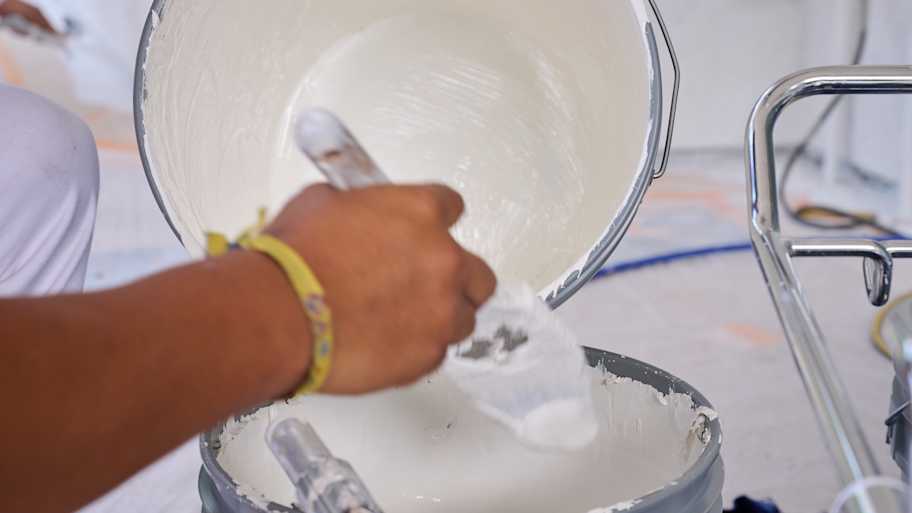Everything You Need to Know About Choosing Environmentally Friendly Paint
Your home won’t be fuming with these paints


Walking into a freshly painted room is a beautiful sight—but the smell?—not so much. Many paints offset unpleasantly strong and potentially hazardous chemicals into the air that give off this odor, but not all paints give off a whiff of indoor air pollution. Here’s what you need to know about environmentally friendly paints.
A Brief History on Paint Manufacturing
Though paint has been used for thousands of years, mass production just began in the 19th century. The refinement of the paint manufacturing process brought to light the nature of some of the chemicals used to make the products.
That was when the link between exposure to high levels of lead and developmental disorders in children was discovered, and lead paint was deemed an illegal additive in 1978. Today, multiple laws are enacted to protect both contractors and consumers from being exposed to dangerous chemicals, but not all substances that can cause harm are banned from the market.
What Is Environmentally Friendly Paint?

Environmentally friendly paint contains fewer VOCs, biocides, and fungicides than regular paint. These paints also tend to have higher amounts of natural pigments and ingredients.
The Environmental Protection Agency (EPA) states that paint with VOCs in the range of 5 grams per liter or less can technically be branded as “zero VOC,” although the product may still contain colorants and biocides that are made up of harmful chemicals. Typically, low-VOC paints have no more than 50 grams per liter. Oil-based paints contain high levels of VOCs, whereas water-based paints usually contain much lower levels of harmful chemicals.
Environmentally Friendly Paint vs. Conventional Paint
Environmentally friendly paint contains fewer VOCs than conventional paint. It also tends to contain naturally occurring ingredients like clay, milk, chalk, natural latex, and/or mineral pigments. Some environmentally friendly paint comes in containers made with post-consumer recycled materials like glass or plastic.
Conventional paint contains more VOCs and may use synthetic fungicides, biocides, and pigments. You might save on conventional paint; latex-based paints cost around $15 to $50 per gallon and oil-based paints cost anywhere from $20 to $60 per gallon, while environmentally friendly paints cost between $40 to $60 per gallon and may need more coats of paint.
What to Avoid When Choosing an Eco-friendly Paint
Before you dig into what you’re looking for in paint, it can be helpful to know what you shouldn’t look for while you’re choosing environmentally friendly paint. Here are a few paint ingredients to avoid:
Volatile Organic Compounds
The biggest health concern with conventional paints comes from volatile organic compounds (VOCs). These compounds are man-made chemicals—like formaldehyde, ammonia, toluene, and benzene—which occur in the paint manufacturing process to dissolve the other ingredients.
Unfortunately, these ingredients can cause health problems like nausea, respiratory issues, eye irritation, and even cancer, according to the EPA. New air quality regulations for VOC levels went into effect in 2005, requiring an industry-wide reformulation of paint and stain products.
But, while the EPA regulates some VOC levels via the Clean Air Act (CAA), indoor VOCs are hard to regulate because VOCs vary depending on the product and the number of other household items that also contain the compounds.
Acrylic Colors
Who hasn’t opened a tube of acrylic paint to playfully do some art? The familiar smell that comes with acrylic paint is often the scent of VOCs. Some acrylic paint contains chemicals like lead, cobalt, cadmium, and more, as well. Most acrylic paint does not contain these ingredients, but it’s important to check the label to make sure that it’s non-toxic.
Oil-Based Paints
Oil-based paints contain high amounts of VOCs, whereas water-based paints usually contain much lower levels of VOCs, though you should always read the label to be sure your water-based paint has low VOCs.
Latex Paints
Unless the latex paint in question blatantly states it has low LOVs, avoid purchasing latex paints due to their high levels of VOCs. Some of the ingredients in latex paints are pose hazards to aquatic life if they were to enter storm drains.
Best Environmentally Friendly Paints

The EPA advises buying paint with a low concentration of VOCs, biocides, fungicides, and high amounts of natural pigments to ensure that the product is as eco-friendly as possible.
Keep an eye out for the following ingredients, which are the safest for your health and the environment:
Lime putty
Linseed oil
China clay
Plant resins
Natural latex
Beeswax
Chalk
Talcum
Mineral pigments
With these ingredients in mind, check out these markers for finding the most eco-friendly types of paint for your next home project:
1. Green Seal-Certified Paints
Green Seal is a leader in environmentally friendly standards for paint and other household products. As such, the nonprofit defines low-VOC paint as paint that has 50 grams per liter or less. Though some paints tote a VOC-free status, paint that contains five grams per liter or less can use “zero VOC” branding.
Twenty-five potentially hazardous inorganic and organic ingredients are banned from Green Seal’s rigorous standards, so you know that you’re choosing the safest paints for your home when you opt for the Green Seal label.
2. UL GREENGUARD-Certified Paints
Another top certification to look for in your hunt for environmentally friendly paint is the UL GREENGUARD certification program. This program tests emission standards to ensure indoor air pollution levels from VOCs are at an all-time low.
Choosing a product with the GREENGUARD Certification or GREENGUARD Gold Certification is an easy way to know that the product you’re applying to your walls complies with the strictest safety standards.
3. Zinc Phosphate Paints
To keep unsightly mold and mildew from growing on the outside of your house, all exterior paints contain fungicides and biocides. Though these ingredients are unavoidable, there are more environmentally friendly exterior paints out there. For an eco-friendly option, look for paint that contains zinc phosphate as the active fungicide and anticorrosive ingredient.
Zinc phosphate helps keep paint adhered to surfaces and lowers the chance of corrosion. It’s also much safer than other anticorrosive ingredients like zinc chromate and formerly used lead oxides.
4. Limewash Paint
Limewash paint has been around for centuries and is one of the most affordable and environmentally friendly paint options on the market. Limewash only contains two basic ingredients—lime and water—though you can add natural pigments to it to change the color. This paint has a very matte appearance that’s perfect for bringing out dimensions on a feature wall in your home.
5. Milk Protein Paint
Milk paint consists of a milk protein called casein and is an eco-friendly replacement for paints containing mildewcides. True milk paint is also made from just two low-cost ingredients—milk casein and lime—though sometimes pigments are added to the paint. Because milk paint contains lime, it has a similar matte appearance to limewash paint, but it’s not as pronounced, making for a more subtle vibe.
6. Clay Paint
When thinking of clay, the first thing that comes to mind is likely sculpted figures and that one art class you took back in middle school. But believe it or not, you can use clay as a healthy alternative for finishes on your walls and ceilings.
Clay contains natural ingredients derived from the ground itself and also has an earthy, pigment that’s additive-free. This paint will be sure to add a warm, adobe look to your green interior design with its stucco texture.
7. Low-VOC Paint Brands
Some companies manufacture paints with low levels of toxins and VOCs. These brands include:
Sherwin Williams
Harmony
ProMar 200
Behr Premium Plus
Benjamin Moore’s Natura and Aura lines
You can also find plenty of environmentally friendly paint options by searching for the ecolabel or skimming the EPA recommended standards.
Paint types have important health and environmental implications, but you shouldn’t be intimidated. If you feel stuck by all the different paint options available, hire a professional painter near you for advice.















